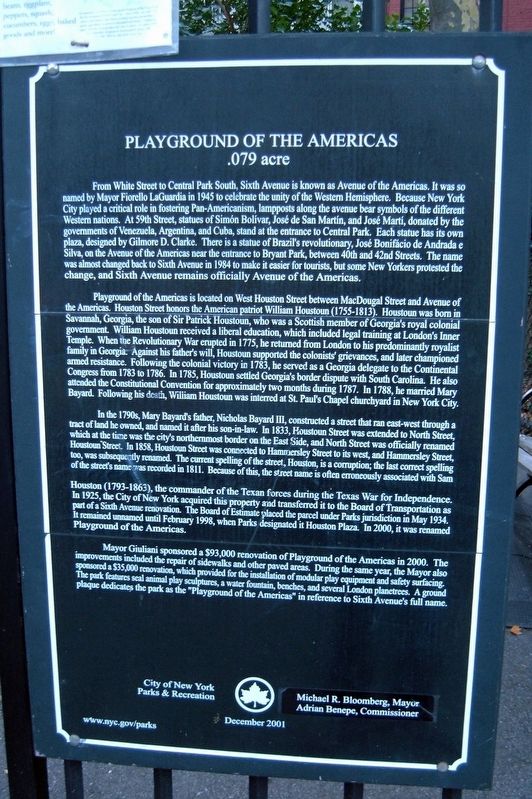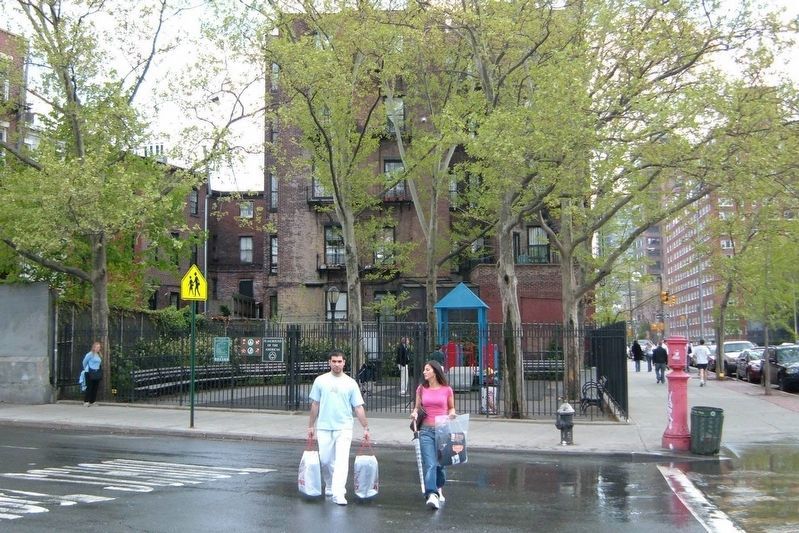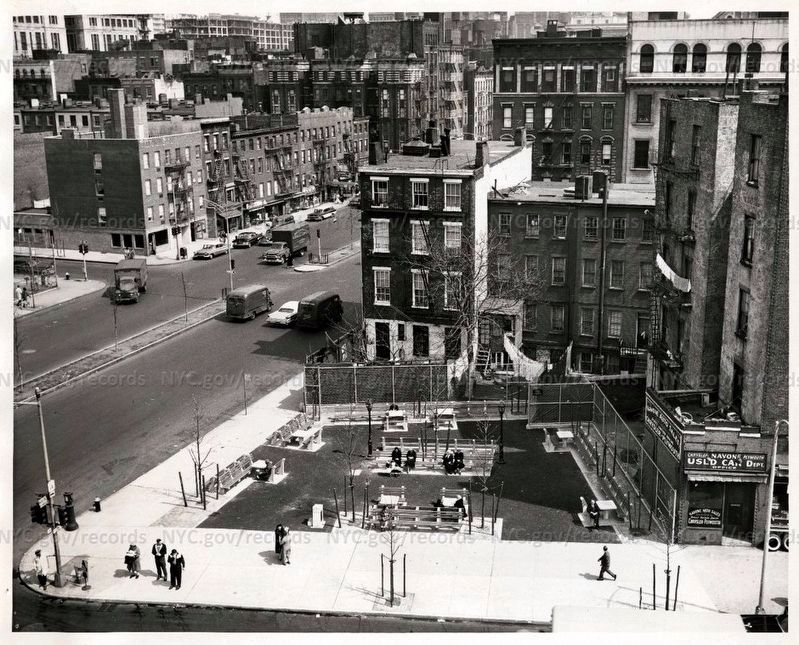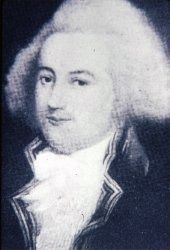SoHo in Manhattan in New York County, New York — The American Northeast (Mid-Atlantic)
Playground of the Americas
.079 acre
From White Street to Central Park South, Sixth Avenue is known as Avenue of the Americas. It was named by Mayor Fiorello LaGuardia in 1945 to celebrate the unity of the Western Hemisphere. Because New York City played a critical role in fostering Pan-Americanism, lampposts along the avenue bear symbols of the different Western nations. At 59th Street, statues of Simon Bolivar, Jose de San Martin, and Jose Marti, donated by the governments of Venezuela, Argentina, and Cuba, stand at the entrance to Central Park. Each statue has its own plaza, designed by Gilmore D. Clarke. There is a statue of Brazil’s revolutionary, Jose Bonifacio de Andrada e Silva, of the Avenues of the Americas near the entrance to Bryant Park, between 40th and 42nd Streets. The name was almost changed back to Sixth Avenue in 1984 to make it easier for tourists, but New Yorkers protested the change, and it officially remains Avenue of the Americas.
Playground of the Americas is located on West Houston Street between MacDougal Street and Avenue of the Americas. Houston Street honors the American patriot William Houstoun (1755-1813). Houstoun was born in Savannah, Georgia, the son of Sir Patrick Houstoun, who was a Scottish member of Georgia’s royal colon8ial government. William Houston received a liberal education, which included legal training at London’s Inner Temple. When the Revolutionary War erupted in 1775, he returned from London to his predominantly royalist family in Georgia. Against his royalist father’s will, Houstoun supported the colonists’ grievances, and later championed armed resistance. Following the colonial victory in 1783, he served as a Georgia delegate to the Continental Congress from 1783 to 1786. In 1785, Houston settled Georgia’s border dispute with South Carolina. He also attended the Constitutional Convention for approximately two months during 1787. In 1788, he married Mary Bayard. Following his death, William Houstoun was interred at St. Paul’s Chapel churchyard in new York City.
In the 1790s, Mary Bayard’s father, Nicholas Bayard III, constructed a street that ran east-west through a tract of land he owned, and named it after his son-in-law. In 1833, Houstoun Street was extended to North Street, which at the time was the city’s northernmost border on the East Side, and North Street was official named Houstoun Street. In 1858, Houstoun Street was connected to Hammersley Street to its west, and Hammersley Street, too, was subsequently renamed. The current spelling of the street, Houston, is a corruption; the last correct spelling of the street’s name was recorded in 1811. Because of this, the street name is often erroneously associated with Sam Houston (1793-1863), the commander of the Texan forces during the Texas War for Independence. In 1925, the City of New York acquired this property and transferred it to the Department of Transportation as part of a Sixth Avenue renovation. The Board of Estimate later placed the parcel under NYC Parks jurisdiction in May 1934. The playground remained unnamed until February 1998, when NYC Parks designated it Houston Plaza. In 2000, it was renamed Playground of the Americas.
Mayor Giuliani sponsored a $93,000 renovation of the Playground of the Americas in 2000. The improvements included the repair of sidewalks and other paved areas. During the same year, the Mayor also sponsored a $35,000 renovation, which provided for the installation of modular play equipment and safety surfacing. The park features seal play sculptures, a water fountain, benches, and several London plane trees. A ground plaque dedicates the park as the “Playground of the Americas” in reference to Sixth Avenue’s full name.
City of New York Parks & Recreation
Michael R. Bloomberg, Mayor
Adrian Benepe, Commissioner
December 2001
Erected 2001 by City of New York Parks & Recreation.
Topics. This historical marker is listed in these topic lists: Colonial Era • Parks & Recreational Areas. A significant historical month for this entry is February 1998.
Location. This marker has been replaced by another marker nearby.
It was located near 40° 43.688′ N, 74° 0.156′ W. Marker was in Manhattan, New York, in New York County. It was in SoHo. Marker was at the intersection of West Houston Street and Sixth Avenue, on the right when traveling east on West Houston Street. Touch for map. Marker was at or near this postal address: Playground of the Americas, New York NY 10012, United States of America. Touch for directions.
Other nearby markers. At least 8 other markers are within walking distance of this location. A different marker also named Playground of the Americas (a few steps from this marker); Lieutenant John A. Garcia (within shouting distance of this marker); Firefighter Thomas P. Hannafin (within shouting distance of this marker); Engine 24 ◆ Ladder 5 (within shouting distance of this marker); Battalion Chief William J. McGovern (within shouting distance of this marker); Firefighter Faustino Apostol, Jr. (within shouting distance of this marker); Engine 24 Ladder 5 and Battalion 2 of the New York City Fire Department 9/11 Memorial (within shouting distance of this marker); Firefighter John A. Santore (within shouting distance of this marker). Touch for a list and map of all markers in Manhattan.
Related marker. Click here for another marker that is related to this marker. This marker has been replaced by the linked marker.
Also see . . . Official NYCP&R site. (Submitted on January 17, 2020, by Michael Herrick of Southbury, Connecticut.)
Credits. This page was last revised on January 31, 2023. It was originally submitted on January 17, 2020, by Larry Gertner of New York, New York. This page has been viewed 92 times since then and 8 times this year. Photos: 1, 2, 3, 4. submitted on January 17, 2020, by Larry Gertner of New York, New York. • Michael Herrick was the editor who published this page.



